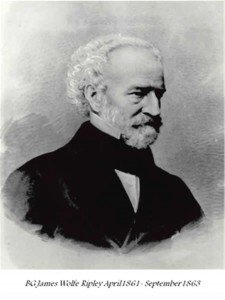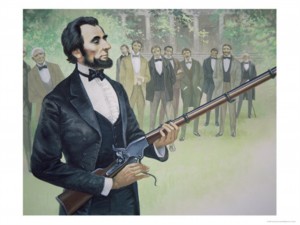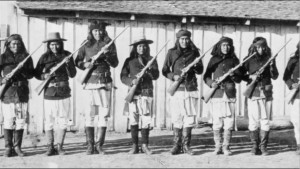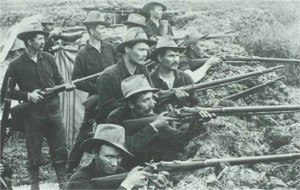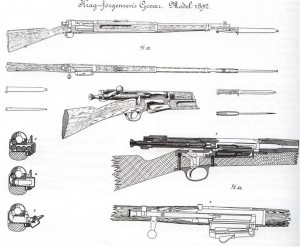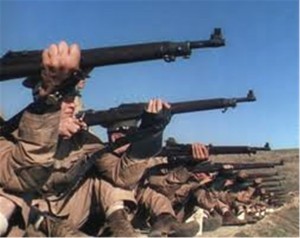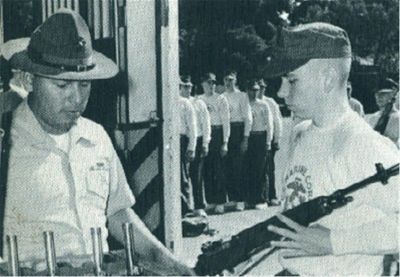 Author's with his first M-14
Author's with his first M-14 Essay by Yankee Papa (all rights reserved)
What a difference a century makes:
Springfield Daily News, 31 August 1967 –
“ARMY CONCEDES M16 GUNPOWDER TROUBLE. Washington (UPI) – The Army says the controversial M16 rifle – praised and damned by GI’s in Vietnam – has a minor bug* which is being corrected. *(My italics)
Or not:
“The subcommittee found that the M16 rifle as originally developed was an excellent weapon but that modifications made to the rifle at the insistence of the Army (Ordnance Department) were unnecessary and were not supported by test data….
The Subcommittee’s review confirmed many of the reports of excessive malfunctions experienced with the rifle in South Vietnam. The group also agreed to a degree with the statements of various defense officials that malfunctions were caused by lack of proper training, maintenance instructions, cleaning equipment and daily care of the rifle.
However, the subcommittee charged that the major contributor to malfunctions has been the use of an ammunition not designed nor developed for use in the weapon. The M16 rifle was developed and tested with one type of powder in the ammunition. In 1964 the Army changed to a different powder without adequate test data.
The adverse effect on the M16 of ammunition loaded with the newly adopted powder was known to the Army as early as March 1964, yet the Army continued to procure the ammunition in great quantities for use with the M16 in Vietnam.
The Subcommittee report states that Army officials were advised by the gun manufacturer that more than half of the rifles would fail to pass the acceptance test called for under the contract if the test had to be conducted using ammunition loaded with the new powder.
The contractor was allowed to use the original powder for test purposes in order to get the rifles accepted by the Army. According to the Subcommittee report, the Army handling of this ammunition problem ‘borders on criminal negligence.’
The subcommittee said that the modifications made by the Army not only degraded performance but increased the unit cost of the weapon in certain instances.” – Ichord Committee Press Release, Oct. 19, 1967.
From 1777 to 1968 the Ordnance Department had the responsibility for development, production and acquisition of firearms for the United States Government. While there were positive accomplishments… the history of the institution was often stained with arrogance, insubordination to the highest authorities… and even criminal malfeasance…
At the start of the American Civil War the Union Army had rifled muskets… muzzle loaded… firing a Minie “ball” (actually shaped like modern bullet…) The hollow base of the round permitted it to be dropped into the barrel easily after the powder had been poured in…but expand to fill the grooves when fired by percussion cap. Percussion fired smooth bores still in Union and Confederate arsenals were replaced within months.
Instead of being lethal at 100 yards, the rifle was deadly beyond the ability of the average soldier to aim… out to 1000 yards. Loading in the prone position was not impossible… but very awkward and slow.
Other weapons systems were out there… Single shot Sharp’s rifles and carbines… firing (at first) paper cartridges… followed by more modern self-contained rounds… both breech loading… higher rate of fire and much easier and faster to load… including in the prone position.
The Spencer carbine could fire seven rounds… the trigger guard functioned like a Winchester lever… though the hammer had to be cocked prior to firing. The Henry lever action was the most desired by troops… even though it fired what amounted to a pistol sized round.
The military department responsible for equipping the troops in the field was opposed to purchasing or issuing any of the breech loaders. The general commanding the Ordnance Department (James Ripley) had been born in 1794. Due to the War of 1812 he had been graduated after only 18 months at West Point.
General Ripley had more than 45 years in service and ignored direct (written) orders from President Lincoln instructing him to get better weapons out to the troops. (Lincoln once wrote out a government check personally to an inventor to purchase two proto-machine guns… both were ultimately used in fixed defense positions at a bridge on the Potomac…)
The insubordinate fossil running the department was opposed to any progress for a number of reasons. He was convinced that what the troops had was good enough and simple to supply. Any greater speed and ease of loading and firing would (in his opinion) result in greater cost and troops shooting up all of their ammunition in no time flat.
(This argument would be used into the 21st Century even though endless amounts of evidence and after action studies showed that well trained troops manage their ammunition consumption in line with circumstances and unless cut off from their supply lines almost never shoot themselves out of ammunition.)
He also tried to justify his insubordination on the grounds that if these weapons were captured that the South would gain a large advantage. This was both at odds with his earlier disparagement of the newer weapons… and disingenuous… The Confederacy barely had what it took to manufacture replacement ammunition for muzzle loaded rifles… They never could manufacture significant amounts of ammunition for the breech loaders (they tried…)
So instead… the North lost countless muzzle loading weapons into the hands of the Confederates that they *did* have the ability to keep supplied with ammunition. Looking at an early start to equipping the troops… the war may have lasted a full year longer than needed…
Ripley was forced to purchase some Sharp’s carbines and many Spencer carbines for the cavalry but continued to dig in his heels regarding breech loading rifles for line outfits.
Berdan’s Sharpshooters had been promised Sharps rifles and instead the Ordnance Department issued them with Colt rifles… which were both inferior and extremely dangerous. The unit announced that it was going to mutiny… The Secretary of War was able to force Ordnance to issue the Sharps.
Ripley had a system. If you were an inventor or manufacturer and your project involved breech loaders… he would not see you. If he was forced to see you, he was extremely rude and told you that the Army had no use for your weapons and told you to get out.
If for some reason he was forced to go to the next step, he took your proposal and filed it… permanently. If forced to go to another step… he “studied” it… forever. If forced to go beyond that, he cherry picked a very hostile committee to study the proposal and after rigged tests… reject it.
If somehow he had to go beyond that, he would suddenly give you a contract with an impossible delivery date… then void the contract because of non-compliance. If the weapons somehow got produced… he often refused to issue them… pretending that he did not have them.
If forced to provide the weapons, he would sometimes have them sent to the home base of the unit rather than their current location… sometimes hundreds of miles away from the battlefields where they were urgently needed. Other times he would send the weapons… but not the ammunition and play games forever before the units could get what the Republic had paid for.
If negative information of any kind re breech loaders reached Ripley, he played it for all that it was worth. On the other hand, when General Fremont sent a splendid letter of praise… Ripley gave it a file number… put that file number on some other document… and destroyed the real one.
Lincoln was not able to simply fire the old fool… since Congress at that time had control of the matter. In theory he reported directly to the Secretary of War. In point of fact, because of friends in Congress, he was almost untouchable.
Lincoln did at last get legislation through giving him power to retire any officer with more than 45 years service. He did so in this case… though he had to compromise with Congress on the replacement… and the replacement violently disliked the Secretary of War.
The bulk of the Army was made up of volunteer units from the States. Many bought (or were issued at private expense by their commanders) breech loading rifles, including the new Henry’s… Those weapons purchased by regimental commanders were auctioned off, (along with other equipment that they had purchased) at the end of the Civil War… (The origin of modern auctioneers being given the honorary title, “Colonel…”)
Within a year after the war, the Ordnance Department had taken all breech loading rifles out of the hands of the remaining infantry… The cavalry continued on with whatever they had.
In late 1868 the department reluctantly agreed to the conversion of Springfield muzzle loading rifles to breech loaders… The last so-called Allin Conversion converted them to what would be called “Trap-door Springfields…” in 45.70… A couple of years later, cut down carbine models were issued to the cavalry in 45.55….
The department was embarrassed by having so many Sharp’s rifles and carbines and Spencers… and some Henry’s in stock. Needing to make them go away… it was cleverly decided to declare them “obsolete” and sell some on the civilian market and give many others to the Indian Bureau to issue to Plains tribes for “hunting…”
At the Little Big Horn, because of a drought that year and the nature of the terrain… the greater range of the Springfields counted for little…
Between dust and ground features (the Indians rode to battle but largely fought on foot in the Custer fight… the small number of dead Indian ponies on the battlefield confirms that…) the longest range that a trooper could see to fire was 50 yards… The Indians with their repeating rifles did quite well at that range… *and rate of fire counted for far more than theoretical range superiority in that engagement…*
It did not help that the contract for copper casings was given to the lowest bidder. The cheap copper would deform from the heat if the weapon was fired rapidly for a period of time… ultimately breaking off while still in the breech as the extractor failed to remove it.
Broken tips of knife blades were found around a number of bodies of troopers with Custer wiped out on the Greasy Grass. Some have tried to play down the problem, stating that only 3% of empty cases show extractor damage. However, many men would not have had time to mess with a jammed carbine and would have had to resort to their revolvers. Of course the victorious Indians made off with all of the carbines.
At Reno hill the problem was pronounced. One officer had a ramrod in his gear (carbines did not have) and it was constantly passed back and forth. (This would happen in Vietnam as well before the M-16’s jamming problems cured…)
On the other hand, Reno (and more to the point) Benteen were able to hold their position on the ridge above the Little Big Horn because of the greater range and (brush) penetration of the Springfields.
For most of the rest of the 19th Century the Trapdoor Springfields kept being improved. Near the end of the century the joke was that it was the most improved obsolete rifle in the world.
The department at last agreed to provide new rifles using “smokeless powder” to the regulars. The Krag-Jorgensen was issued just prior to the Spanish American War.
The Krag was a beautiful weapon… in sheer beauty of workmanship probably the finest ever issued to American troops. But it had some built in flaws…
As with the early British Lee-Enfield, there was a “cut-off” that disconnected the internal magazine. This resulted in the weapon being used as a single shot most of the time, but with five rounds in the weapon that could be “switched on” if in danger of being overrun or given brief opportunities to blaze away at a fleeing enemy…
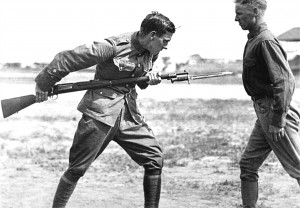
Soldiers continue to train with the Krag during World War I due to shortages of M1903 Springfield rifles. (National Archives)
But the internal magazine of the Krag, unlike the Lee-Enfield, had to be loaded one round at a time into the side… no stripper clip function. The underpowered round was inferior to the Mauser rounds used by the Spanish troops in the Spanish American War.
Most of the American forces in the Spanish American War and in the early days of the Philippine Insurrection were volunteers and were still using the black powder Trapdoor Springfields.
President Theodore Roosevelt had faced Mausers in Cuba and told Ordnance that he wanted a better rifle than the Krag. If need be, buy Mausers from the Germans. Instead, Ordnance stole the design.
In 1903 the Ordinance Department at last got their act together and issued the 1903 Springfield. No very long version for infantry and very short for cavalry… one size that (amazingly) fit all.
The 1903 had many fine features… some, like the immensely strong bolt locking system were obviously stolen from the German Mauser…So obvious was it that the American government was forced to pay a lot of money to the Germans for swiping their patents… The “boat-tailed” bullet design was also swiped… Again, the government had to settle. In both cases the Government settled immediately without even bothering to go to court.
The stripper clip design had also been stolen… but Ordnance fought the lawsuit… The suit was held up because of WWI… During the war the U.S. Government in effect confiscated the patent… After the war the Government paid to settle… not for the strippers… but for confiscating the patent… which violated a treaty that we had with Germany at the time. In 1920 the Government was forced to pay (with interest) more than $400,000. for the treaty violation (ca. 5 million dollars today)
Fast forward to WWI… The first American troops into France carried the Springfield 1903 in 30.06… Later troops carried the inferior Springfield 1917.
A major scandal took place because at a time when the troops were being issued broomsticks in training… the production line of 1917s and machine guns sat idle for months (with workers drawing full pay…)
Turns out that Ordnance didn’t seem to care that there was a war on… They wanted to fine tune and fiddle with the 1917… and debate endlessly about what machine gun to manufacture. One member of Congress went on the production floor and took photos.
The Chief of Ordnance, General William Crozier (1901-18) was one of the more insubordinate department heads in an institution where being mule-headed was the norm. No matter how reasonable many of these officers seemed earlier in their careers… once appointed, it was as if they became the Pope. And the First Commandment was that Ordnance, not the officers in the field would determine what weapons were best.
Crozier single- handedly prevented the adoption of a Maxim type machine gun early in his reign. He let personal antagonisms provoke him to select a dead-end machine gun rather than the excellent Lewis gun. (The Lewis gun sold to Britain instead by the inventor. Marines showed up in France in 1917 with Lewis guns but Ordnance confiscated them.)
The British and French told the Americans to only bring their small arms… they would issue machine guns and artillery.
When the Americans refused to be fed into Allied units in company sized lots, the Allies started dumping junk weapons on them. The British refused to give them any excellent Lewis guns.
The French dumped Chaut-Chaut (“show-show”) light machine guns on the Americans. Probably the worst firearm issued to troops (in large numbers) in the Twentieth Century… of the many thousands made, parts could not be interchanged without a gunsmith filing away…
A half-moon magazine was open in the middle one one side so that you could see how many rounds were left…no covering on one side… just bullets that you could touch.
On any battlefield this would invite dust and mud… but on the muddy battlefields of the Western Front… The weapons were almost useless. After the war the manufacturer (and his government agent brother-in-law) went to prison.
Back in the States, the Americans had the excellent Browning Automatic Rifle (B.A.R.) The B.A.R. was made deliberately heavy… being viewed as a portable light machine gun. The weight made it easier to control when firing.
Ordinance refused repeated orders to send them overseas because (they said) eventually the Germans might capture some and make their own copies…(using that logic, we should have issued only clubs to our troops…)
On September 13,1918 some made it into combat with one division (79th), but Pershing was persuaded to quickly take them off the line (Hallahan, MISFIRE)
In late 1918 Crozier wound up in front of Congress. They demanded to know what he did with the five million dollars that they gave him to provide tools and dies to various American factories to make 1903 Springfields. He blithely answered that he spent it on pistol production.
Money given him for machine gun production had also not been spent as dictated by Congress. His tenure as head of Ordnance was over.
While the French, Germans and Italians had some early model sub-machine guns (machine pistols) the Russians decided to go with a full auto rifle designed to be issued to line outfits… as a rifle… not (like the B.A.R.) as a light machine gun.
Their rifle used the full sized rifle round and a box magazine. It proved absolutely impossible to control in full-auto mode… and even in its semi-auto version only saw limited service.
Between the wars the Ordinance Department decided to go with the M-1 Garand… They might have gone with a .276 caliber. At the last yawning moment they decided to stick with 30.06…(In large part because the Army had vast stocks of 30.06 ammo and the Chief of Staff, General MacArthur knew that Congress would not go for a new caliber…)
There were all kinds of experiments before the Garand design was final. Serious thought by developers about adding an external magazine (a sort of proto-M-14…) But nonsense muttered about too much ammo… losing magazines… and being awkward for close order drill with attached magazines. (If not in combat, why a magazine… if you are… why in hell close order drill?)
Armory production managers originally rejected the rifle. Their “experts” said that they needed 20,00 man-hours of study time for planning, and 200,000 hours of engineering and design time. John Garand ignored them and quickly did all the design work himself.
His reward once production was underway was a recommendation from a high ranking officer in Production that Garand be dropped to save the cost of his $ 3,600. annual salary. That did not happen, but it showed what 16 years of genius level work could get you at Ordnance.
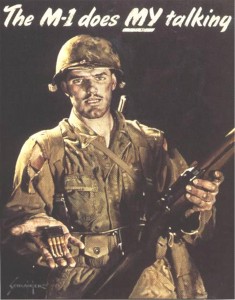 And so America would go into WWII with the best mass issue rifle then available… (though the Marines would not get theirs until after Guadalcanal and some Army units would not get theirs even later after they got to North Africa…)
And so America would go into WWII with the best mass issue rifle then available… (though the Marines would not get theirs until after Guadalcanal and some Army units would not get theirs even later after they got to North Africa…)
The Germans got rid of most of their very long barreled Mauser rifles and went mostly with the so-called “carbine” version… Plenty of range and accuracy and far easier to carry and use.
The Germans made good use of machine pistols (SMGs) but found that, especially in Russia, something was missing. Bolt action rifles were accurate… but with far greater range than was normally needed… Recoil was high and rates of fire low… SMGs had good rate of fire, but lacked range and penetration… the first very important when masses of SMG equipped Russians were stampeding their way.
At first the Germans tried a semi-auto rifle using normal Mauser ammunition… An improvement, but only a few thousand were manufactured.
Hitler, with his WWI prejudices refused to allow any new design rifles (including the semi-auto) to be mass issued to regular line outfits… said to just issue more machine guns. German paratroopers had a full auto rifle available… but it used a full size rifle cartridge and was impossible to control in the full auto mode… In semi-auto it was far more formidable…
To get around Hitler’s order prohibiting new rifle designs, the German designers designated their latest design as the MP-44… MP implying machine pistol…
Studies, then and later, showed that even on the Russian Front that the vast majority of infantry combat took place within 300 meters. A Mauser was designed for at least 500 and had sights out to 1000. The MP-44 was designed for the more realistic ranges. It would prove to be the first assault rifle.
The MP-44 pretty much designed itself… They needed something larger than a pistol or carbine round… but smaller than a full size rifle round. The result was called an “intermediate” round, significantly larger and more powerful than pistol and carbine rounds, but smaller than full size rounds.
The medium size round meant that far more could be carried. The reduced recoil meant that reasonable…5-6 rounds bursts of full auto fire could be employed with decent accuracy. A pistol grip aided in control.
The use of 30 round curved (to aid in feeding and prone firing) magazines helped keep up a good rate of fire. Stampings were used whenever possible to reduce weight, keep down costs, and simplify wartime production.
The weapon was a big hit with both the German troops and their commanders. After it had been in the field for some months somebody spilled the beans to Hitler praising the new “rifle…” He had approved a new “machine pistol…” not a new rifle. But reading the reports he reluctantly agreed to let the present scale of production continue… fortunately small enough numbers not to be able to inflict massive damage on the Allies.
After WWII both the Russians and the future NATO countries decided to look into new weapons and ammunition. The Russians, in the last year or so of the war had the SKS… small, light, semi auto, with greater range and accuracy than a SMG.
In spite of later protests of 100% originality, the AK-47 being developed owed its basic theory and outer design to the MP-44. Many improvements and excellent design features were doubtless original, but the MP-44 was the direct ancestor of all assault rifles.
The future NATO countries, especially Britain, wanted to go with a new rifle caliber… not too unlike the future 5.56mm. The U.S. was the 800 pound gorilla and said no. Until the end of the Korean War all NATO forces used what they had already.
The Ordnance types decided that they would go with an improved M-1 rifle. This might have made sense right after WWII and would have certainly been handy during the Korean War… but it was a trifle late in the day.
The first thought was merely to open the bottom of the Garand and ram in a 20 round magazine. Some problems with that… and more importantly problems involving the excellent 30.06 round. The 7.62 is a tad smaller than the 30.06 but in supposed to be better in full-auto mode.
Ordnance scaled down the designs for the M-1 and made the needed changes to accommodate the new round (always easier to design down on an existing blueprint…) Add the 20 round magazine and the M-14 was born.
The M-14 may not have been what was really needed… but it was certainly a fine weapon… once its many manufacturing troubles were out of the way. Wrong metals used and a lot of production had to be scrapped.
There were three areas where it was weak. The first was the wooden upper hand guard that could not handle the heat of so many rounds going downrange… this was quickly replaced with a closed plastic one.
The second problem was the wooden stock… while attractive, wooden stocks belong on the wall, not in the hands of troops in the field. They absorbed moisture and quickly lost the “zero” that the infantryman had worked so hard to obtain on the range.
Plastic stocks were developed for Vietnam… but by the time they were ready, most troops had M-16s. All of the M-14s still in use by American forces these days have plastic stocks.
The third problem was that Ordnance overreached. The M-14 would not only replace the Garand… but would also replace the B.A.R. One in four weapons would have a selector switch (though all could be fitted with one…) The full auto version was supposed to have a pistol grip stock (though not too many of those were made) and also have a heavy barrel (though not too many of those were made either…)
Even with the pistol grip the M-14 on full auto was no better than the WWI Russian full auto rifle. A well-built expert marksman could not keep even short bursts on target. The result was that in combat American troops almost never used the M-14 in full auto. The last nail in the full auto coffin was the demand that the M-14 not have a “straight line” design (“Doesn’t look like a proper rifle…”) but rather have a “drop…”
This left fire teams without their automatic rifle. One answer might have been to have scaled down the BAR to 7.62 and maybe had a 25 or 30 round magazine.
Since our NATO partners had their arms twisted into accepting the 7.62, they mostly went with the FN from Belgium. The Israelis followed suit, gradually replacing their Mausers and .303s. The U.S. gave its allies every reason to believe that it was going to go with the FN… but then went with the M-14 after all.
The FN also had a heavy barrel version… but it was only slightly better than the M-14 in the full auto mode and those troops with selectors seldom fired their FN’s in combat in full auto.
New conflicts in new places were presenting opportunities for new weapons. Eugene Stoner had one… the ancestor of the M-16. (AR-15…all versions hereafter referred to as M-16…)
As originally designed the M-16 was lighter, handier and more dependable than what eventually went into mass production. Of course it was cursed from the start by Ordnance for “Not being invented here…” The bureau had just finished the M-14 and was ready to sit on its laurels for the next 50 years.
The M-16 was dismissed as too fragile, not enough range, not sturdy enough for bayonet combat, too small a round… and worst of all… having full auto capability. Ordnance ran a few quiet tests and then just filed away the results.
The AR-15/M-16 might have died then and there except for General Curtis Le May. Heading up the Air Force, he wanted the weapon for his MPs and combat recon and rescue groups. An order was placed. Ordnance did not like this but just shrugged and hoped this would be the end of it.
American advisers in Vietnam wanted M-16s for the South Vietnamese soldiers. Many at not much more than 90 lbs had more than a little difficulty with the Garand. Ordnance wanted no more production of the M-16 and told the advisers if size was a problem to issue M-2 carbines… (!!!)
Ordnance was going into full guerrilla warfare mode, worthy of Ripley and Crozier. They would do anything to kill the M-16. The staff got the word… Ripley’s tactics would be used and improved upon.
Unfortunately for Ordnance the Army was in the middle of a breathtaking set of experiments… culminating in what would eventually become the first Airmobile division in history… the 1st Air Cav. Its leaders wanted the new weapon and got it.
The first major combat between American forces and NVA regulars took place in the Ia Drang valley in Vietnam. In spite of elite troops, brilliant artillery and air support and the M-16… the 1st Air Cav barely got away with it. A ten to one kill ratio is impressive, but somewhat less so if you are, in the end, overrun and wiped out… which might have happened.
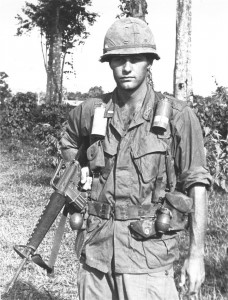
1st LT Thomas K. Holland, D Trp., 1st Sqdn., 9th Cav., Vietnam. United States Army Heritage and Education Center
Hal Moore gave much credit to the M-16… not that it won the battle by itself, but the M-14 at such close range might have been like the Springfield at the Little Bighorn.. more reliable than the Springfield, to be sure… but too slow a rate of fire. On barren Korean hilltops the M-14 would have come in handy, but not in Vietnam.
The North Vietnamese were *very* impressed with the weapon. Orders went out to bring back any that fell into their hands (this would change when problems later arose…) While the M-16 was not as good a “peasant gun” as the AK-47… for regular troops it was a superior weapon… especially its 5.56mm round. For all of its virtues the AK-47 had an inferior round… which would eventually be replaced by the Russian/Afghan war.
Other American forces with M-14s had shot it out with the NVA and sometimes found themselves outgunned. Five hundred yard effective range meant nothing at 200 yards or less in the face of massive firepower.
The rest of the Army knew about the Ia Drang, the M-16, and the after-action studies. They wanted the M-16 and they wanted it yesterday.
At first Ordnance hoped that just a few units in a small isolated war would require the weapon… but it soon became apparent that that it would soon be a mass issue weapon. Something had to be done.
They could no longer make it go away. They had gone so far in earlier days as rigging the tests. They sent M-16s to the Arctic command for testing… with sights removed… The rifle was declared to have “failed” the 800 yard test… when the weapon not designed for it.
In competition with M-14s… the 14’s got match grade ammo… the M-16s regular. Armor penetration tests… M-16s tested for full auto when 14’s not. “Rain tests” for 16’s… not for 14’s… Jungle testing not done until well into the Vietnam war… (other than by troops at the sharp end…)
Many other foul deeds were done (Rottman, M-16), but after the Ia Drang the M-16 was going to be it.
Consoling themselves that American forces in Europe still used the M-14… Ordnance decided to “improve” the M-16… much as the MG-42 had been “improved…” to become the M-60.
Ignoring the basic premise that an assault rifle would almost always be used at 300 meters or less, Ordnance decided to increase the “twist” in the barrel to increase range. This somewhat reduced the wound damage and had other effects.
In the worst Arctic cold “ball” powder had a slight advantage over IMR powder. Ignoring the fact that the M-16 was specifically designed to operate with IMR powder, and that all foreseeable use of the weapon would be in the tropics, Ordnance decreed that all ammo going to troops would have ball powder. A powder designed for a weapon with stopped production was going to a brand new one designed for a different type… and without testing for possible effects.
This increased gas port pressures by 500 PSI… more heat on the gas tube, far higher rate of fire than the weapon had been designed for… and combined with increased fouling… now made the weapon prone to stoppages, jamming and other battlefield nightmares.
While the M-16 was not designed to “go without cleaning”, ball powder fouled the weapon more, impeded operations and made the weapon less reliable. Early Army instruction pamphlets indicated that the M-16 needed little cleaning… and that the bolt did not require lubrication. Both very wrong. Combat failures with the ball ammo became frequent.
Rather than admit its mistake Ordnance plunged ahead… chrome plating the chamber and ordering the installation of an abortion known as a “forward assist assembly…” Heavier buffers added.
Cleaning kits were not immediately issued below battalion level. Proper instruction was not given to the troops as they swapped out their weapons. Combined with ball powder ammunition the results were horrific in the first weeks and months of use.
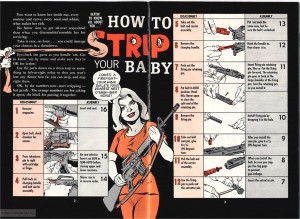
Treat Your Rifle Like a Lady – The Will Eisner M-16 U.S. Army Rifle Maintenance Booklet. Officially known as DA Pam 750-30.
Troops were sending away mail order for civilian cleaning kits. Ultimately military cleaning kits (the very first ones were too flimsy… and small brushes needed) and better instruction and training took care of many of the problems…
Ordnance stuck firmly to ball powder. Like tobacco company executives in denial… They would ultimately rather have soldiers die than admit their error. Comments were made to the press about how the problems were because of the low quality draftees (doubtless incapable of fire discipline…) “improperly” caring for their weapons… (exactly as instructed…)
Their criminal responsibility was proved beyond doubt by their certification process. Colt indicated up to 50% failure of new rifles to qualify if tested with ball powder. Colt was facing bankruptcy unless something done…
So Ordnance sent Colt an official letter authorizing them to test all M-16s “with any ammunition that it wished…” The weapons would be tested with the ammo that it was designed for… but sent to Vietnam with a different type of ammo proven to alter performance and cause serious problems.
In the summer of 1967 the Ichord committee of Congress went to Vietnam, observed, took testimony and returned to the States. Hearings were held and a 600 page report was issued. Many witnesses from Ordnance when asked about testing, standards, changes, and authorization to Colt often replied, “I don’t remember…” Congress and the Defense Department not amused.
In 1968 the Armory was closed down. In 1969 Aberdeen Proving Ground Museum set up a Wall of Fame to salute those who were “greats” in Ordnance. Among the first two selected… Generals Ripley and Crozier.
But years later some called for a more complete investigation showing just what the actual damage was and just who was responsible. One U.S. Senator had gathered evidence and was ready to start hearings on the matter… when the Watergate hearings started and his proposed hearing was permanently shelved.
After that, it was “yesterday’s news…”
YP

